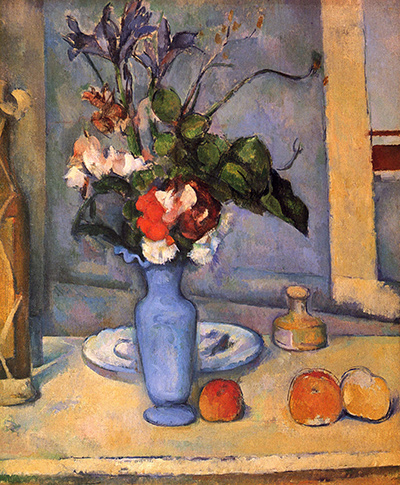The Blue Vase is an 1889 painting by Paul Cezanne. The painting media is oil on canvas, and it measures 61 x 50 cm. The painting current location is Musée d'Orsay, Paris.
The painting depicts flowers in a blue vase and some fruits on the surface. Sections of two pictures frames are seen in the painting background and a wall covering making a slight diagonal across the picture.
A table stands in front, hidden off by both ends of the picture sides. The table lower edge is slightly above the bottom edge of the picture, and it’s nearly parallel to the painting.
A plate, a bottle, and another vessel are on the table next to the vessel containing flowers on the table. On the foreground, three apples lie in line with the vase.
The minor objects on the painting are carefully organized in the interplay of horizontal, vertical and diagonals. The range of colors used in the painting depicts Cezanne’s skills in achieving equilibrium. The brightest colors are seen on the flowers where white is juxtaposed with red, and green with white.
The harmony of the painting is generally put together by the subtle range of different blue shades that are accompanied by contrasting pale and orange ochre as complementary colors. The tallest flower that dominates the composition forms a group of turquoise around the central blue vase making this painting to stand out as highly skilled artistic work. The artist wanted to depict the beauty of flowers in this painting.
Cezanne was more interested in color modulation in this painting rather than representing flowers in bloom. He used the subject to depict his skills as an artist to show the effects of light on objects that result in color variation. The sobriety and apparent simplicity of this painting are far hidden by the richness and exuberance that are incorporated in Renoir’s floral compositions.
The artist created space through a clever interplay of horizontal and vertical line and the even distribution of volumes and achieving total harmony by the use of different blue colors.
Cezanne used the color technique in this painting to add more quality and make it attractive to viewers. A close observation of the painting tells the viewer the artist was aware of color effects on objects. In the blue vase painting, he utilized his analytical skills on perceived distinct shapes placed together to come up with an overall form. The use of other vessels on the table near the flower vase makes the painting to have a natural look.
The Blue Vase painting also gives the viewer the impression that the artist intended the painting to be as natural as possible. The use of warm and bright colors makes the painting to be visible from a distance with the flower vase catching the viewer first. A close look at the painting shows there is more than the flower vase because of the other objects on the table. The artist added a rich background to make painting attractive and make the other objects to be visible.




